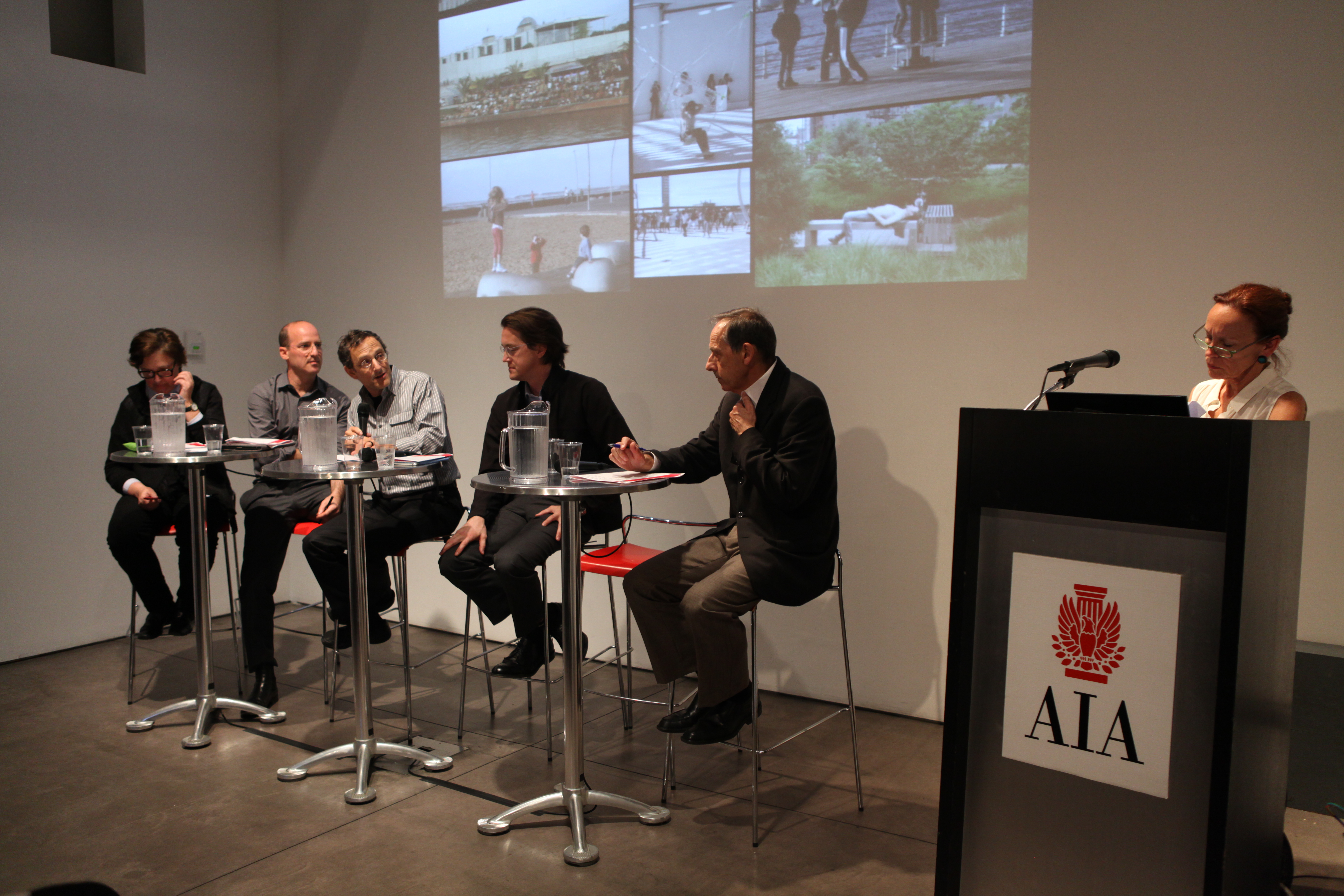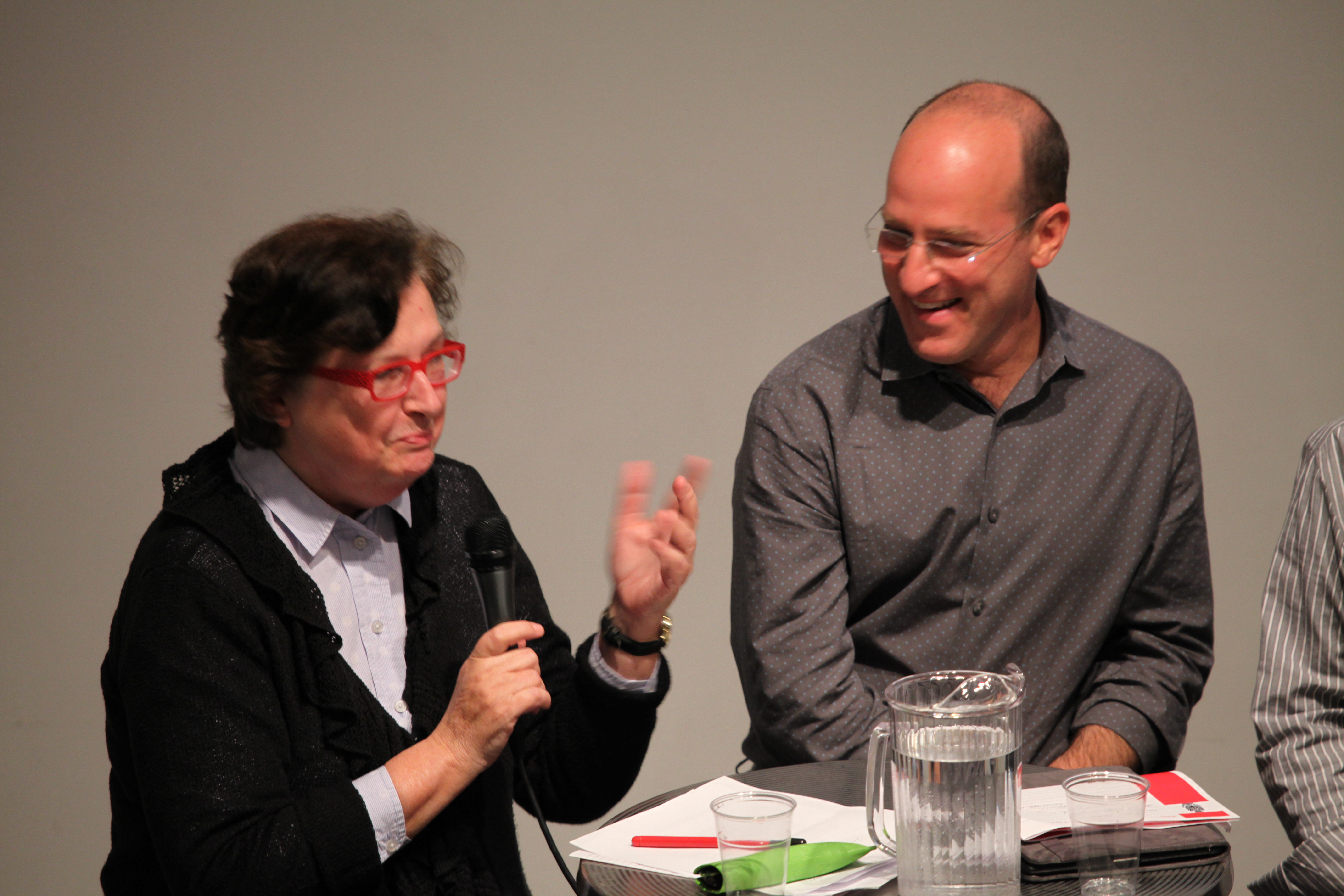by: Melissa Marsh
On Monday 09.16.13, the AIANY Marketing & Communications Committee, in its penultimate event of the year, took on the topic of our converging digital and built worlds from a uniquely marketing-oriented perspective – namely, a focus on the ability of public space to play a role in communications – both political and advertising in nature. The panelists, introduced by Signe Nielsen, FASLA, principal, Mathews Nielsen Landscape Architects, and president of the Public Design Commission of the City of New York, explored a range of topics through each of their own works and practices. The conversation included technological entertainment installations in public space, digital signage for safety and way-finding, next-generation philanthropic sources, and leveraging of marketing dollars for public media.
Nielsen defined a charge to the marketers of and the design firms which create or contribute to public spaces as seeking ways to “embrace contemporary technologies into spatial constructs which foster human engagement… designing and marketing public spaces as responsive, experiential, social, provocative, active,” rather than simply as “park, plaza, or square,” as has been done in the past. Introductions were followed by panelist conversations around both recently-built projects and observations about the various intersections between public and digital in the world around us.
Campbell Hyers, CEO of the Control Group, shared anecdotes of two recent projects that are bridges between the digital and physical world, and also call into question the public-ness of these media and who they serve. First, a competition for the redesign of NYC public payphones; and second, an installation of iPads at the LaGuardia Delta Terminal. The first is an officially public element that needs to leverage media sales to support infrastructure costs and serve the public interest. Meanwhile, the second is a private commercial interest whose implementation serves the public by creating a more desirable waiting environment at the airport. Hyers and Metropolis Editor-in-Chief Susan Szenasy, Hon. AIA, saw two sides of the coin here, noting the benefits of private entities bearing the costs of development and systems maintenance, but also the risks of doing so.
David Burney, FAIA, commissioner of theNew York City Department of Design + Construction (DDC), initially confessed an ambivalence, even apprehension, about the digital world and its benefits to society. He began a thread of conversation, that would finish with Szenasy regarding the importance of physical activity, open space, and getting people out into the real, physical world through accessible public spaces and compelling environmental designs. In the end, Burney saw the greatest possibility in combining the two, with wireless access in public open spaces bringing more people and getting them to stay longer.
Nielsen challenged Stephen Cassell, AIA, LEED AP, principal of Architecture Research Office (ARO), and John Schapiro, chair of the Pratt Institute Graduate Center for Planning and the Environment, to describe the impact of an increasingly digital world, and how, as designers, we aim to create livable, human, and sustainable environments. Cassell spoke of “digital desire lines,” and the potential for technology to enable the design of public spaces to be more aligned with public preferences. He commented on the absence of inherent way-finding in a digital world where we use maps on mobile devices rather than our own sense of direction. Finally, he speculated that all of these factors may change the design process itself. While Shapiro also discussed the changing design process, he focused on the interrelationship between management, stewardship, and technical design delivery. His take on technology focused on how we might improve performance and maintenance of public spaces through technology, communications, and design.
Szenasy served as a default second moderator, quickly identifying areas in which the other panelists had omitted an important element of human or social consideration. She expressed concern about the broader public impacts of technology, from the elimination of jobs to reduced frequency of human interaction. She challenged Hyers on the intersection of both technology-mediated and realworld experiences, and she highlighted the need for scrutiny of the public-ness of anything that included a funded marketing message.
The diversity of the panel was effective in presenting a broad definition of both marketing and place – spanning from existing implementations to future possibilities, and from marketing for to marketing through public spaces. However, there seemed to be a couple of threads still missing: The panel focused more on technology in public spaces than on public spaces in a virtual world. There was also limited conversation on the digital enablement of what might be considered the purpose of public space – to bring people together, to provide access to nature and other resources that might not be affordable to the general public, and to elevate us all through exposure to these resources. We have good reason to reconvene and continue the conversation.
Melissa Marsh is a workplace strategy and change management consultant with a passion for social research and an architectural education. She is celebrating the one-year anniversary of founding her own company, Plastarc, Inc. She is a new contributor to e-Oculus, and can be reached at melissa@plastarc.com.
Event: Inside Out and Outside In: Public Spaces in a Digital World
Location: Center for Architecture, 09.16.13
Speakers: David Burney, FAIA, Commissioner, New York City Department of Design + Construction; Stephen Cassell, AIA, LEED AP, Principal, Architecture Research Office (ARO); Campbell Hyers, CEO and Partner, Control Group, Inc.; John Shapiro, Chair, Pratt Institute Graduate Center for Planning and the Environment; Susan Szenasy, Hon. AIA, Editor-in-Chief, Metropolis; Signe Nielsen, FASLA, Principal, Mathews Nielsen Landscape Architects; President, Public Design Commission of the City of New York (moderator)
Organizers: AIA New York Marketing & Communications Committee, and Debra Pickrel, Principal, Pickrel Communications













